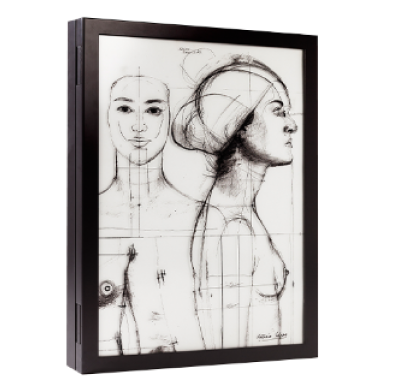Antonio López shares his impressions on Landscapes
The artist from Tomelloso shares some moments experienced during the creation of the work Landscapes, his impressions, and what it has been like to collaborate with ARTIKA. This is a unique opportunity to learn more about his emotions, memories, and vision of art.
And if you prefer to enjoy Antonio López’s words in written form, we have included a transcription of the artist’s statements here.
Landscapes begins with the work of his uncle and his wife, María Moreno.
In this book, there are three of us, but what’s beautiful is that my uncle is included, who belongs to a previous generation and is like the beginning of it all. My uncle is at the beginning, not because we copied him, but because he showed us a path. It could have been someone else, it could have been Hopper, it could have been Balthus… There were some marvelous figurative painters in the 20th century, one of them close to all of us was my uncle. And I think that example has helped us a lot. And I find it beautiful that he is in the book and that he opens it.
In the closing photograph of Landscapes, you appear with your wife and painter, María Moreno.
Ah! It’s wonderful. By then, Mari was not well, but you can sense all the sensitivity and how well we got along. It shows how two people can get along very well for many years despite all the difficulties and the patience required to achieve that.
How did the idea of including your text in Landscapes come about?
Then, naturally, as it took time to make the book and we talked a lot, the possibility naturally arose that, in addition to the title, some words or very simple data would appear that everyone could understand because they are works to be understood. They are works that can be explained. It’s a specific place in Madrid, a specific place in Tomelloso, a specific date… and there are anecdotes that are real, they are true, and they are linked to the work. So, I think all that has made the book more agile and given it charm. My words.
You become aware that you have to choose from all the anecdotes you could tell; you have to choose the anecdote or the two anecdotes that are the most decisive, the most expressive, the ones that say the most about the work. And that depends on you too. You also have to make a selection because instead of telling this, you could tell something else. And then you’ve chosen a story related to the painting, and that’s a mental exercise that is good because it makes you more aware of why you do things. That’s good. Having to explain it is good if you don’t lie.
The cover of the book is a detail of the painting Gran Vía, August 1, 7:30 AM. A painting done from a window.
In my work, I have painted the street either at street level or from inside a place. So, in this case, it was from inside a place, and I liked incorporating the interior. I liked incorporating it because you can paint what is seen without including the interior, and then it looks like a landscape seen from above. But I found it very interesting to incorporate the window frame, part of the window. I found it very interesting because it created the world of the interior and the world of the exterior, and that contrast was stimulating, and I found it attractive to incorporate.
The first thing that surprises me is seeing the small size. And it’s as if you had moved far away. And it takes on a very different character; it becomes more detailed, almost like a jewel. You don’t see so much the struggle of the painting, but you see the magic of what’s achieved. The magical part of the painting.
It’s a majestic book, it’s a wonderful book; I think it’s very well done.
Landscapes includes a giclée print with the image of some flowers.
It’s a theme I haven’t stopped painting since very early on. Like the city. Since 1953, during a holiday, I was studying Fine Arts, halfway through my studies, during Easter holidays at my parents’ house, there was a garden. And my mother had flowers. And I saw some wallflowers. With a fragrance, it was wonderful.
I liked them so much that I put them in a glass with water and painted a picture during the holidays. And, of course, well, since then I’ve been painting flowers.
And I paint very different flowers, especially roses. I go back to roses because roses have a variation of tones; a rose remains a rose, but a white rose is not the same as a pink rose, a red rose, or a yellow rose. They are very different. They give you a very different feeling. These were pink roses, like flesh, very fleshy. And they smelled a lot. So, I painted everything looking for that very physical quality that the roses had.
What value does it have that you signed all the copies of Landscapes?
I think the intention is to create a book different from the normal, that goes beyond, that has something of a very individualized work, made in an extremely close way to what it reproduces. You can’t go further. Beyond this, you would have the painting itself.

